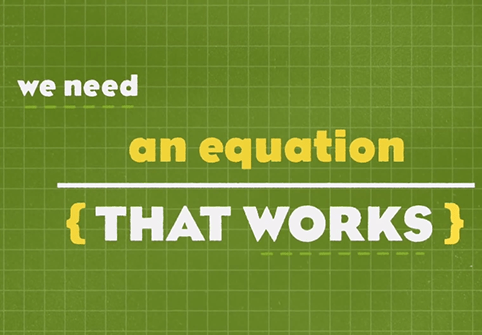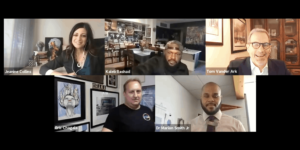Getting To An Equation That Works

This blog first appeared on edu@scholastic.
David Dockterman
We’re in trouble. Math defines the algorithms that increasingly drive our lives. Recommendations for what to watch, read, eat, and buy come from analyses of the data of our daily existence. Prices, traffic lights, and customer service responses all get their signals to change from mathematical equations. From medicine to marketing, from engineering to entertainment, math underlies and informs decisions and actions. Yet, as a nation, Americans are scared of it.
That fear and incapacity leaves many uninformed and unemployable. Nearly 60% of first-year college students are unprepared for college math, let alone for the rapidly growing number of STEM careers, an estimated 2.8 million of them by 2018. For a lot of reasons – instructional, attitudinal, and cultural – our current equation for math education isn’t working. I’d like to suggest an alternative:
T(C + M) = ∆S.
∆S
Scary looking? It shouldn’t be. The equation, like much of math, is just a short-handed way of describing functional relationships in the world. In this case our output is a change in the trajectory of math learning, represented by the symbol delta, ∆, which means change, and the letter S, which stands for Slope. Roughly speaking, we want to go from a graph of math learning that looks like the one on the right instead of the one on the left.

Currently, many students never seem to get beyond basic arithmetic. A number don’t even make it that far. They flatline (or worse), and every year they are retaught what they didn’t learn in the prior years. Even a slight change in the Slope of their learning can make a big difference over time. Of course actual learning, like physical growth, doesn’t follow a smooth and steady path. It often happens in bursts. So for any individual student, we should expect spikes and plateaus, but I hope you get the idea.
C
The letters on the other side of the equation stand for the inputs and how they work together to generate this desired change in Slope. Let’s start inside the parentheses. C stands Content knowledge. Students need to know some math. It’s unavoidable, but not all math content is created equal. Some standards matter more than others. We want to focus on the big C, the Content that matters most, the mathematical knowledge and skills that provide the foundation for later math learning.
The focus of the K-8 standards in the Common Core and other next generation standards is preparation for Algebra. Those standards follow a progression where early concepts and skills provide a sense-making platform for later ones. Just look at how an increasing number of middle school standards begin with the words “Apply and extend previous understanding…” (see the chart in this document). When students lack these previous understandings, they really can’t move forward in a way that sticks. So instead of pushing students from one grade to the next with mathematical tricks to get them through the next test, this equation calls for rebuilding the foundations that these students never got. Give students who need it the big C – the most essential mathematical knowledge, skills, and strategies – to serve as a platform for acceleration along the path to Algebra.
M
Sadly, just providing Content isn’t enough. Too many students, particularly older ones, have had such a long history of failure in math that they no longer believe that success is possible. And with parents who freely proclaim “I’m not a math person either”, students may not be so sure that math even matters. We need to shift their Mindsets, adding a big M to the big C. None of us is likely to exert much effort toward a task that we see as futile, uninteresting, and unimportant. We need to believe that it’s worth doing, that we can do it, and that if we can’t do it at first, we need to believe that we can get better with focused effort and perseverance. Students need what’s called a growth Mindset about math.
So this equation combines C + M. We need to teach the right Content while simultaneously developing and reinforcing the Mindsets that will fuel effort and perseverance. We need to show students that math is worth learning, that it provides a gateway to exciting future careers. We need to give students evidence of their ability to do math and show them that effort leads to progress. Personalized digital learning environments are particularly good at offering each student tasks that are just a bit beyond his or her reach, Goldilocks problems that aren’t too easy and aren’t too hard. They have just the right amount of challenge to boost satisfaction and self-efficacy. “I can do it, and it feels good.”
T
T, the Teacher, provides a powerful multiplying effect in this equation. The teacher is the most important lever we have for student achievement. The teacher establishes the classroom culture that fosters perseverance, reinforcing that struggle is a natural part of the learning process. The teacher anticipates student mistakes and misconceptions, using them to deepen understanding. The teacher monitors each student’s Content acquisition and Mindset development, adjusting instruction and support accordingly. The Teacher makes it all work.
So this equation includes tools for Teachers to be great – high leverage teaching practices, useful student data, training, and coaching. The better the teacher, the bigger the multiplying impact and the greater the change in the slope of student learning.
For more Getting Smart math blogs, check out:
- Student Centered Learning in Math: A Call to Action
- Getting Smart on Blending Middle Grade Math
- Building Student Centered High School Math Classrooms
 David Dockterman is an Adjunct Lecturer on Education, Technology, Innovation, and Education at Harvard Graduate School of Education & Chief Architect, Learning Sciences at Scholastic Education. Follow David on Twitter at @dockterman.
David Dockterman is an Adjunct Lecturer on Education, Technology, Innovation, and Education at Harvard Graduate School of Education & Chief Architect, Learning Sciences at Scholastic Education. Follow David on Twitter at @dockterman.







0 Comments
Leave a Comment
Your email address will not be published. All fields are required.